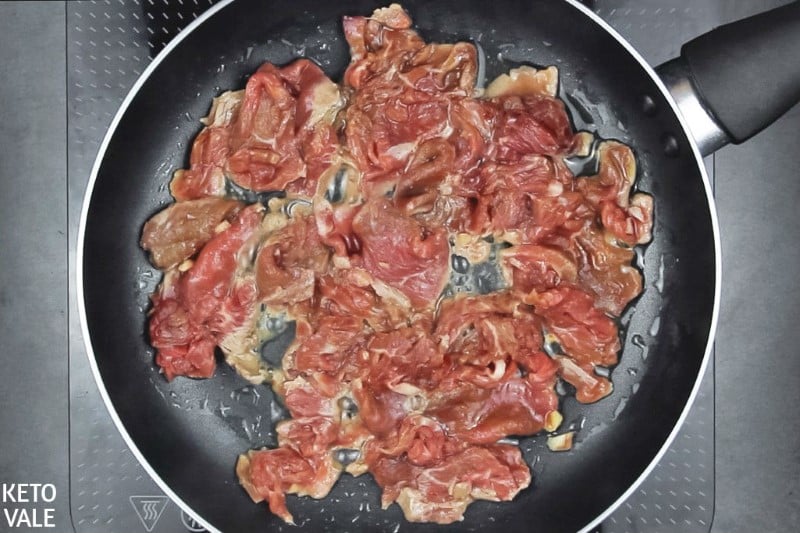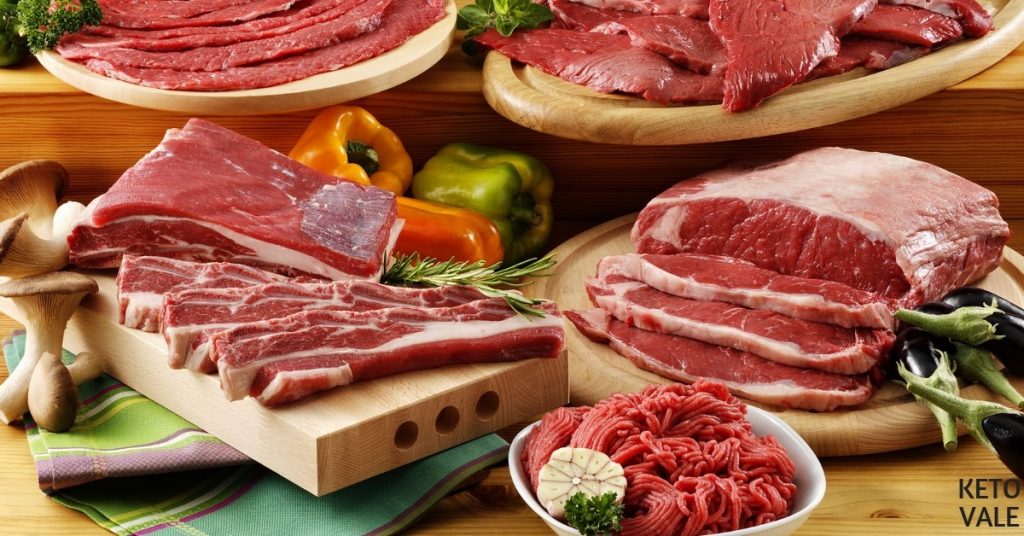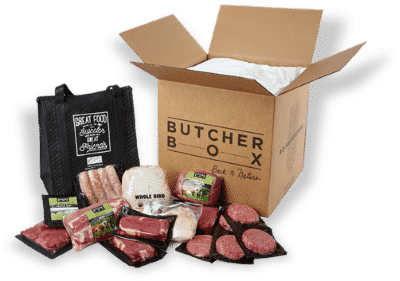Buying beef used to be easy. You would visit your local butcher or grocery store and pick up whatever was freshly prepared that day. But that was before the cattle industry started overusing antibiotics to keep their livestock, well, alive. Now, the news is full of stories about how bad conventionally-raised beef is for you and the environment (1, 2).
Livestock production contributes to approximately 12 percent of the world’s gas emissions, which is bad for the environment because it emits methane into the atmosphere and contributes to climate change (3, 4).
Cows are forced to live in horrific conditions that would otherwise kill them if it weren’t for the antibiotics and drugs that cattle ranchers pump them full of to keep them alive. These antibiotics and drugs have been linked to several health conditions in humans, such as antibiotic resistance, disruption of human gut flora, reproductive issues, and even a risk factor for various types of cancer (5, 6, 7, 8).
Ketogenic dieters consume a great deal of meat, especially beef due to its high fat and low-carb profile. Beef is also a great source of B vitamins and many minerals, including iron, phosphorus, selenium, zinc, and more (9).
But buying the wrong kind could be bad to your health as well as the environment. This article looks at the different types of beef that you can buy and which one is best for you and the animal.
What Are The Different Types Of Beef Available And How Do They Differ?
There are three primary types of beef that you can buy. These include organic beef, grass-fed beef, and grain-fed beef. You can break the grass-fed category down further by purchasing grass-finished beef.
We’ll talk about each one here, what their benefits are, and how they differ from each other and what’s the best choice you should go for when cooking beef dishes.
Organic Beef
Seeing that USDA organic stamp of approval on your food is always comforting. It lets you know that you’re making a good choice.
But when it comes to buying organic beef, things can get a little tricky. It’s a no-brainer to buy organic vegetables because this means that you’re limiting your exposure to pesticides and other chemicals, which have been linked to human dermatological, gastrointestinal, respiratory, neurological, carcinogenic, reproductive, and endocrine effects (10).
However, things aren’t always so black and white with organic beef. By definition, a food product can be labeled organic if it is produced through certain methods.
According to the USDA, these methods include mechanical, biological, and cultural practices that promote ecological balance, conserve biodiversity, and foster the cycling of resources.
Additionally, genetic engineering, synthetic fertilizers, irradiation, and sewage sludge may not be used on organic products.
Organic beef means that the cows have not been given hormones, antibiotics, or drugs that promote a more rapid growth. They are also fed a diet that does not contain GMOs or pesticides.
Here’s the catch. Organic beef does not always mean that the cow was allowed to roam free in pastures or eat grass. Even organic cows might still be confined to small pens and fed a diet of non-GMO grain. Unlike grass-fed or pasture-raised beef, there is no guarantee that the cow was ever exposed to a pasture or sunlight where it could just be a cow.
Yes, organic beef is better for you than conventionally-raised or grain-fed beef because you’re limiting your exposure to pesticides, antibiotics, and hormones, but you’re still eating beef that has been given grain as its primary feed, which is highly inflammatory for most people. There’s a better option for you, and we’ll get to that in a bit.
Grain-Fed Beef
Grain-fed beef or conventionally raised beef is the type of beef you get if you don’t see any special labels on your product. For example, you might see claims that the beef has never been frozen, but it does not mean that any special treatment was given to the cow.
In fact, grain-fed and conventionally-raised cows might go through some of the worst conditions possible. They may be pumped full of antibiotics to keep them alive, given hormones to make them grow faster, and fed GMO food that is full of chemicals and pesticides. These cows may never see daylight or are even let out of their small confinement areas. They’re often injured and are barely cared for. Seeing the horrific conditions that these animals live in pulls at your heart string, even if you’re a meat-loving, ketogenic dieter.
Due to their neglect, conventionally-raised beef is the lowest in nutrients (11). They are also pumped full of antibiotics that have dangerous effects on human health. Research shows that conventionally-raised beef is more likely to contain superbugs, which are strains of bacteria that are resistant to three or more types of antibiotics that are commonly used to treat humans.
An article from Consumer Reports suggested that conventional meat tested positive for five types of bacteria, including Clostridium perfringens, Salmonella, E. coli (as well as O157 and six other toxin-producing strains), Enterococcus, and Staphylococcus aureus. The worst part is that all samples of beef that were tested were found to contain these superbugs. On the other hand, cows that were raised more sustainably without the use of antibiotics, such as organic and grass-fed cows, were less likely to contain superbugs.
Many people buy conventionally-raised grain-fed beef because it’s cheap and they aren’t aware of how bad it is for them. Supporting cattle farmers who raise their cows this way only encourages them to continue this terrible treatment. Human health and the overall health of our environment is at risk as a result. Buying grass-fed and grass-finished beef sends a message to cattle farmers that you prefer a product that is humanely raised and healthier for you.
Grass-Fed Beef and Grass-Finished Beef
The best type of beef that you can buy is grass-fed beef. Specifically, grass-finished beef is best. It refers to cows that have been given access to pastures their entire life instead of being confined to small cages or pens.
Grass-fed cows are fed a diet of grass only with no grains. Research shows that cows who are fed grass-fed diets have a higher healthy fatty acid content. They are also higher in some vitamins and antioxidants.
One study determined that grass-fed cows have higher total conjugated linoleic acid (CLA) isomers (which have the antidiabetic, anticancerogenic, and antiatherogenic effects), and trans vaccenic acid (TVA), which is a precursor to CLA. They also have higher levels of omega-3 fatty acids (12, 13, 14, 15).
Grass-finished beef also has higher levels of cholesterol neutral stearic fatty acids and fewer cholesterol-boosting saturated fatty acids such as palmitic and myristic fatty acids. In other words, grass-finished beef contains more fatty acids that help your cholesterol levels and fewer that raise it.
Other studies have found that grass-fed and grass-finished cows have higher levels of vitamins A and E as well as glutathione and superoxide dismutase, which are antioxidants that have been shown to fight cancer (16).
Grass-fed beef is also better for the environment. Research shows that grass-fed beef helps reduce the carbon footprint. One study found that grass-fed cattle had a reduced effect on greenhouse gas emissions when storage of grassland pasture and sequestration was considered (17).
Additionally, grass-fed beef increases the biodiversity of pasture ecosystems and improves the quality of runoff water that comes from well-cared for pastures as opposed to conventional feedlots.
Even if you’re not overly concerned about the environment, it has to feel good knowing that you’re contributing to something that helps preserve the environment.
What’s The Difference Between Grass-Fed and Grass-Finished Beef?

How different are grass-fed and grass-finished beef?
Grass-fed beef is a term that can be used to describe a cow who has been pasture-raised most of its life. In other words, grass-fed cows were fed grass and nothing else for at least SOME of its life.
However, the term “grass-fed” isn’t well regulated. This means that if a cow has been fed grass at one point in its life, even if it’s not for very long, it can be considered grass-fed. Some cows start out grain-fed and then are sent to pasture while others start out grass-fed and return to a feedlot at the end of their life.
On the other hand, grass-finished cows have never been fed anything other than grass for their entire life. This means that at no point in their life were they ever fed grain.
Because the health benefits of eating grass-fed beef are due to the cow’s ability to graze in pastures as nature intended them to for as long as possible, it’s much better for you to purchase grass-finished meat whenever you can.
Here’s where it gets tricky: grass-fed and grass-finished beef does not always mean organic.
This is because there is no way to regulate the feed of a grass-fed cow. While most grass-fed and grass-finished cows are treated much better than grain-fed cows, you will still want to check and make sure that the beef you are buying contains no added hormones or antibiotics. Most cattle farmers will list this information on their package because they know it’s a huge selling point and it separates their beef from the competition.
It gets even more confusing when you factor in the regulations on the terms and conditions of antibiotic use. “No antibiotics ever” means that the cow has never, ever been fed antibiotics. You might see some packages where it says “no medically important antibiotics used.” This means that the cow has never been fed antibiotics that are commonly used to treat humans, such as amoxicillin, erythromycin, and tetracycline. However, the cow may still have been treated with other forms of antibiotics.
Why You Should Choose Grass-Fed/Grass-Finished Beef
The very bottom line is that grass-finished beef raised without the use of antibiotics or hormones EVER is the best kind of beef you can buy. This ensures that the cows have never been fed grain or treated with antibiotics at any point in their life.
As we mentioned above, grass-fed beef is higher in healthy fats, such as CLA and omega 3 fatty acids. It also contains more vitamin A and E as well as several antioxidants that help treat cancer. When grass-finished cows are also never treated with antibiotics in their life, it means that you are eating the cleanest and healthiest source of meat possible.
One of the reasons why antibiotics use is so controversial in meat production is that it reduces your ability to respond to antibiotics when you need them.
For example, if the only type of meat you eat is grain-fed and treated with antibiotics, this builds up a resistance in your body so that the next time you get sick and require an antibiotic, it won’t work for you.
Leaving a bacterial infection untreated can be dangerous. As we mentioned above, the use of growth hormones in grain-fed cows is also linked to several human problems, such as reproductive disorders, cancer, and hormonal imbalances.
Your first choice in beef should always be grass-finished, but this can be hard to find. Many stores are carrying more brands of grass-fed beef, but as we learned earlier this does not always mean that the cow has never been fed grain.
Additionally, not all grass-fed cows are free from antibiotics and growth hormone use. Always look for beef that is grass-fed or grass-finished and has the words “no antibiotics or growth hormones ever” printed on its label.
Where to Buy High Quality Grass-fed Grass-finished Beef?
Your local butchers and supermarkets should have some kind of grass-fed beef available for you. Buying both grass-fed and grass-finished meat can be a little tricky.
The easiest way to buy 100% grass-fed and grass-finished beef is through ButcherBox.
Their cows are pasture-raised and free to roam. The meat is packed with key nutrients such as vitamins, minerals and Omega-3s. You can read our review of ButcherBox here!
The best news? They deliver this quality meat to your doorstep. You can check their available plans and special deals here!
Conclusion
On a healthy diet, especially the keto diet, beef is one of the best sources of protein you should have on your shopping list and meal plan.
Buying beef hasn’t always been this hard. At one point, your only option for beef was what the local butcher made available for that day. A lot has changed since then. Now, you need to know the difference between grain-fed, grass-fed and organic. The obvious choice might seem to be organic beef, but research shows that grass-fed beef is better for you.
It contains more healthy fats, vitamins, and antioxidants than grain-fed beef. Additionally, organic beef is still fed from a grain feedlot. This means that even though the feed contains no pesticides or chemicals, the cow is still not being fed grass like it was intended to eat.
Grain-fed or conventionally-raised beef is the worst type of beef you can buy. It comes from cows that have been neglected and abused their entire lives, injected with all kinds of antibiotics and hormones, and fed garbage. Grain-fed beef is more likely to make you sick as it contains superbugs that are resistant to antibiotics that grass-fed and organic beef is not.
Not to mention, grass-fed beef is better for the environment and supports cattle farmers who are trying to do the right thing. If you’re on the ketogenic diet, then choosing grass-finished meat that has never been treated with hormones or antibiotics is the cleanest source of meat you can buy.
Finally, if you’re interested in quality meat, don’t forget to our review of the best places to buy beef online.








